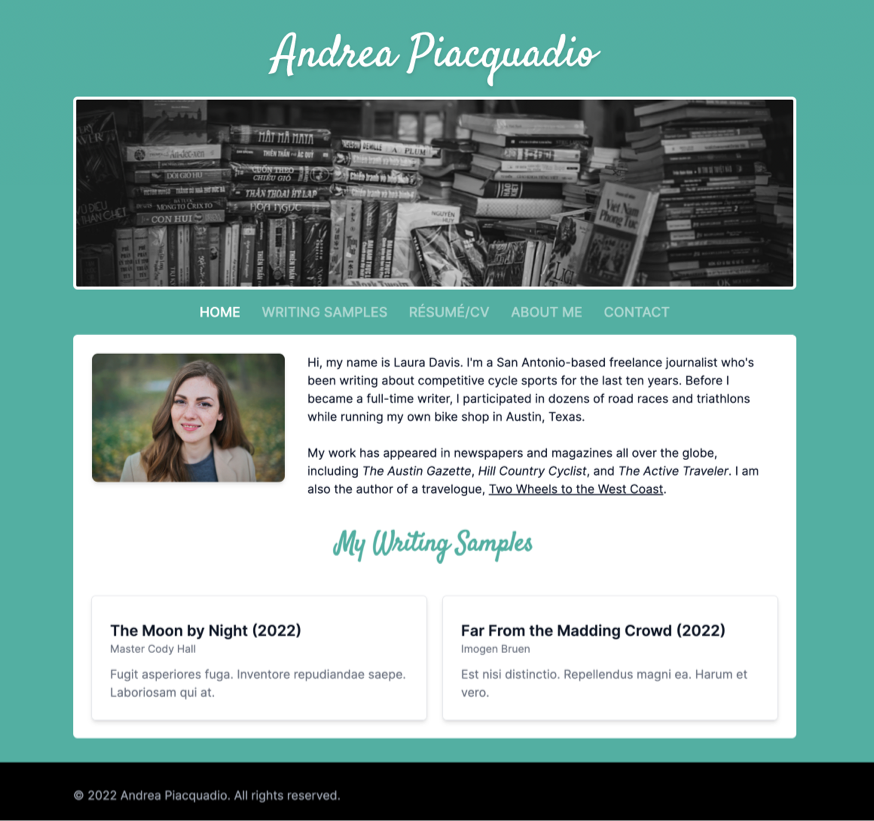
How To Create an Online Writing Portfolio in Five Easy Steps
Written by Monica Shaw
I created my first online writing portfolio over 15 years ago using Wordpress, a great tool if you’re a techie but let’s face it, most writers would rather be writing than messing around with a website. That's why I created this five-step framework for writers who want to create an online writing portfolio but don't really know where to start. In this step-by-step guide, I’ll walk you through the process of creating a writer portfolio that will grab attention and open doors for exciting opportunities. This guide will also help you organize your thoughts and structure your portfolio without getting overwhelmed in the technical minutia.
You'll learn...
- What should be in an online writing portfolio - features that all great gig-getting portfolios share
- Online writing portfolio pre-prep - things you'll need before starting your portfolio
- Five steps to creating an online writing portfolio - and guess what, with this five-step framework, you can have your portfolio up and running in less than thirty minutes
If you're eager to get started, you can plunge in with a 30-Day Trial of Writer's Residence now where we'll walk you through the five-step process as you build your portfolio. Or if you're not sure, read on...
Writing Portfolio Checklist: What Should Be In An Online Writing Portfolio?

✅ Clean, Simple Design That Puts the Writing First
In today's world of flashy websites, too many creators favour design over functionality. Your portfolio should highlight your work, not distract from it. That's why I advocate for a minimalist designs that makes it easy for readers to navigate your writing samples and makes the writing samples a joy to read (plenty of white space, web friendly fonts, etc).
✅ Powerful but Concise Professional Writer Bio
It's time to sit down and think those deep thoughts about your focus and what sets you apart from other writers. Your writer bio should show off your unique value proposition (USP). What are your specialisms? Why are you great at your craft? Focus your author bio on your expertise, experience, and personalitiy. Keep it short but impactful, letting potential editors, clients and hiring persons know exactly what you bring to the table.
✅ Superior Writing Samples - Opt for Quality Over Quantity
Focus on showcasing your very best work. Include a variety of writing samples that demonstrate your range and expertise. Remember, it’s about showing the breadth of your skills, not just the volume of your work. To that end, diversity can be a good thing here! As long as it's easy for readers to find the work that's most relevant to them. On that point...
✅ Clear Organization, With Categorized Writing Samples
Help potential clients find exactly what they’re looking for by categorizing your samples. Whether it's by industry, content type, or theme, organization is key.
✅ Easy to Find Contact Information
Don’t make clients search for a way to contact you. Include clear, visible contact information on every page of your portfolio. This should ideally include your email address and a link to your LinkedIn profile at the very minimum.✅ Client Testimonials and Case Studies
If you have them, include testimonials or case studies from previous or current clients. They provide social proof of your skills and professionalism. Case studies are even more powerful, demonstrating social proof. If you can measure the benefits that your writing brings to your customers, it's time to show that off!
Before You Get Started...
Before you take the plunge and start building your online writing portfolio, there's three things you need to do. Don't skip these steps!
Pick a platform for hosting your writing portfolio.
Naturally I recommend Writer’s Residence as the easy way to get a beautiful online writing portfolio out there quickly and easy. There are other portfolio websites for writers out there, and I've tried and tested them all. My issue with most other portfolio sites is that they over-emphasize design. The problem with that is you end up getting bogged down in choice. We're writers, not web designers, which is why we've created pre-built themes that are designed to take the headache out of design so you can focus on your writing. Our themes are designed to make your writing samples look good and read well for editors, clients, and other hiring persons. You get a generous 30-day trial to give it a go, as well as personal support from me if ever you get stuck.
All this being said, if you use a different platform, that's ok! This process applies regardless of what platform you use.
Gather a few of your best writing samples
These could be links, scanned articles, PDF documents, newspaper clippings, reports, emails, newsletters, or anything else that shows off your writing. If you have a huge portfolio of work, consider trimming down the task to just your ten very best writing samples - you can always add more later. The goal here is to make it manageable. If you're struggling to gather writing samples because you're a new writer, check out my guidance on how to create a writing portfolio with no experience.
Write your writer bio
This is probably the most time consuming step, but it's absolutely essential. How would you introduce yourself to editors and clients? What’s your unique selling point (USP)? Learn more in this post: how to create a compelling writer bio.
My writing portfolio has evolved over the years, but it’s always been built on this simple five step framework.
How To Create an Online Writing Portfolio in Five Steps
1. Add essential details to your portfolio
This is probably the easiest part. Your portfolio should include:
-
Your name - Obviously!
-
Your contact details - People need to know how to reach you and commission your work. Include your email address at the bare minimum, and ideally a link to your LinkedIn profile.
-
A profile picture - As much as I cringe at sharing my picture with the world, it’s a powerful way to add personality to your portfolio and connect with people in this increasingly virtual world.
At Writer’s Residence this is covered in the Profile section of your settings page.
2. Fine Tune Your Home Page
This is the first page people see when they visit your portfolio so make sure it shines. If you've written your writer bio, this part will be easy. Your home page is the ideal place to introduce yourself to your readers who will want to know:
-
What type of writer are you? (Journalist, copywriter, author, blogger, ghostwriter, etc)
-
What's your background?
-
Do you specialize in any particular topics?
-
What makes you special? What's your unique selling point (USP)?
-
Show off a few writing samples that you’re particularly proud of.
- Show off client testimonials that rave about your work.
There’s no hard and fast rules here. Showcase your uniqueness. You can see how I’ve done this in my portfolio or check out these examples from freelance writer portfolios who use Writer's Residence.
As writers who often write for other people, it can be tough to write about ourselves. If you need inspiration, consider using ChatGPT to help with your writing portfolio.
At Writer’s Residence we provide writers with some placeholder text to get them started, and have a feature that allows writers to showcase their chosen writing samples on their website.
3. Add Your Best Writing Samples
This is pretty obvious! Your writing samples will depend on the type of writer you are, but can include:
-
Links to work that have been published online
-
Scanned work or clippings in PDF, PNG, or JPG format
-
Video or sound recordings of work that you’ve written
-
Business documents
-
Press releases
-
Research papers
-
White papers
-
Flyers
-
Poetry
-
Novels
-
Plain text
Upload your best work to include in your writing portfolio. If you’re new to the business and struggling to gather writing samples, read our blog post on how to create a writing portfolio if you’ve never been published.
At Writer’s Residence we support writing samples in any format and allow hosting for an unlimited number of writing samples. In this way your writing portfolio can also serve as an archive of your work.
4. Add Your Resume
This isn’t absolutely necessary but it always helps to showcase your work history, experience, and any special awards or affiliations.
At Writer’s Residence we have a simple resume builder that makes it easy to build out your resume in a format that’s suitable for the industry.
5. Edit Your Portfolio’s Design
Most writing portfolio services offer design options, from basic themes to fully customizable templates. Now I know this is all about freeing up your time to write rather than fiddling with a website, but a few simple tricks can help you personalize the design of your portfolio website and cultivate a unique brand.
-
Use a header image that reflects the type of work you do (much of my work is in the great outdoors so I’ve made this a feature of my portfolio’s header image). I'm also a big fan of Fiverr for affordable logos and image assets for use on my websites and in social media.
-
Use colors to set the mood - most services offer a range of color palettes that you can choose from.
-
Use a website theme that favors functionality over design.
At Writer’s Residence, we let our users choose from three totally customizable themes. To make it easy, we have a set of headers, color palettes, and fonts that you can choose from, or go totally custom with your own header and color selection.
With these five fundamental pieces of an online writing portfolio, you can be online with a sharable portfolio with minimal effort. I’m of course biased and think that Writer’s Residence is the most straightforward option out there. Feel free to try it yourself!
FAQs
How can a writer effectively integrate multimedia elements, like videos or podcasts, into their online writing portfolio?
To integrate multimedia elements into an online writing portfolio, you can embed videos or audio clips that showcase their work or related content. This can include video interviews, podcasts, or multimedia stories you've produced, providing a dynamic element to their portfolio that appeals to a broader audience and showcases a range of skills. FYI: Writer's Residence supports embeded multimedia!
What are some advanced customization options for writers who have coding skills and want to further personalize their portfolio?
Writers with coding skills can utilize advanced customization options by directly editing the HTML and CSS of their portfolio. This allows for unique designs, interactive elements, and personalized features that standard templates may not offer, giving their portfolio a distinctive edge in a crowded market. Top tip: Writer's Residence supports custom CSS which you can edit in the Settings.
Can the writer track the performance of their online portfolio, such as visitor numbers or engagement with their content?
Tracking the performance of an online writing portfolio can be achieved through analytics tools that monitor visitor behavior, such as Google Analytics. By analyzing data on page views, time spent on the site, and bounce rates, writers can gain insights into their audience's engagement levels and preferences, helping them to refine their content and presentation to better attract and retain viewers. Learn more about SEO for writers and how you can integrate top notch SEO standards into your writing portfolio.
Ready to share your online writing portfolio?
Don’t forget, we’re on hand to help you launch your portfolio during your 30 DAY FREE TRIAL.
Get started for FREE